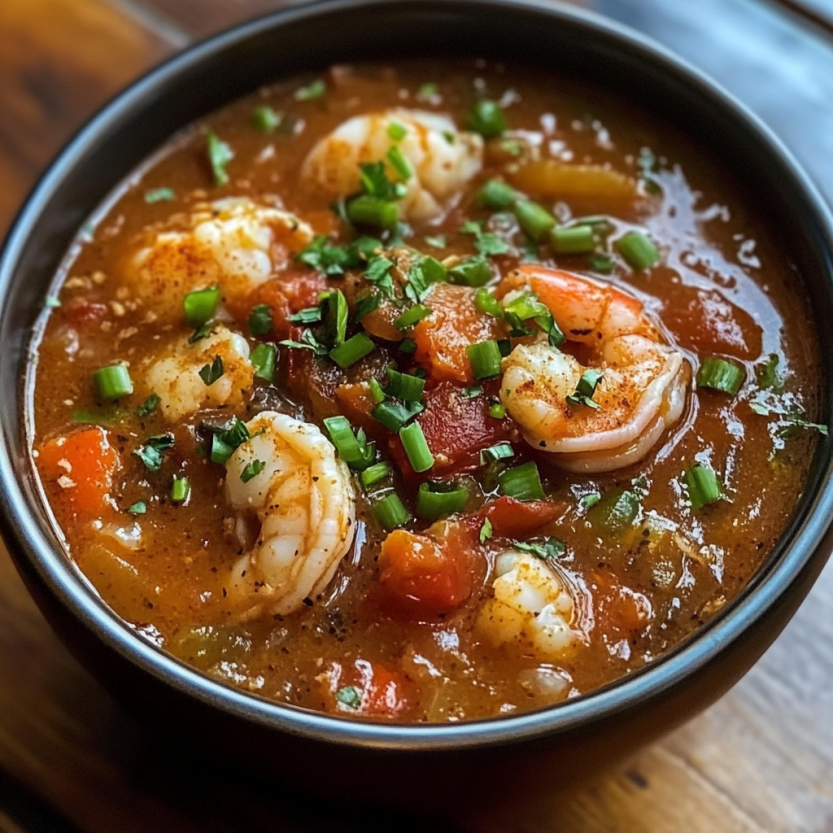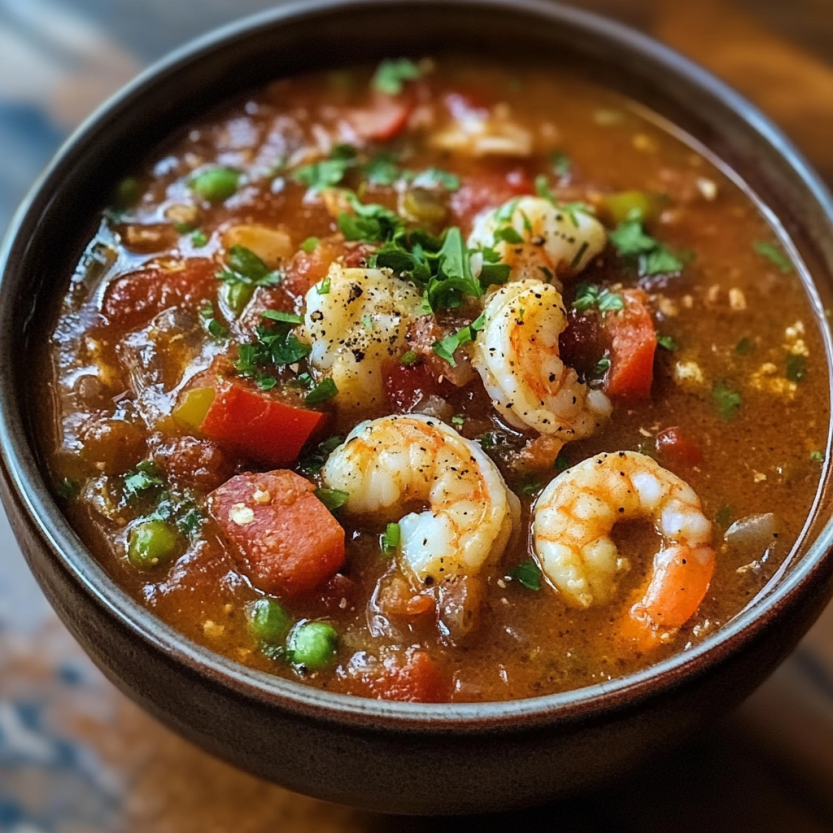 Bookmark
Bookmark
This hearty Louisiana Seafood Gumbo brings authentic Creole cuisine right to your family table. The rich roux base combined with fresh seafood creates a dish that's both comforting and impressive, perfect for weekend gatherings or special weeknight dinners.
I first made this gumbo after a trip to New Orleans where I fell in love with the depth of flavor in authentic Creole cooking. After several attempts to recreate that magic my family now requests this dish whenever we want to transport ourselves back to Louisiana without leaving our dining room.
Ingredients
- All purpose flour: Creates the foundation for your roux giving this gumbo its signature thickness and nutty flavor
- Vegetable oil: Pairs with flour to create an authentic dark roux that provides color and depth
- Andouille sausage: Offers smoky spicy notes that complement the seafood beautifully use the most authentic version you can find
- Shrimp and crab meat: Are the stars of the show look for wild caught American shrimp and fresh lump crab when possible
- Bell pepper, onion and celery: Known as the Holy Trinity in Cajun cooking provide the aromatic base
- Garlic: Adds pungent depth use fresh cloves rather than pre minced for best flavor
- Stock: Chicken or seafood forms the liquid base homemade stock elevates the flavor tremendously
- Okra: Traditional thickener that adds unique texture and flavor choose fresh when available
- Cajun seasoning: Brings authentic Louisiana flavor look for brands without excessive salt
- Worcestershire sauce: Adds umami depth and slight tanginess
- Rice: Serves as the perfect canvas for soaking up the rich flavorful broth
Step-by-Step Instructions
- Make the Roux:
- This foundational step requires patience and attention. Combine flour and oil in a heavy bottomed pot over medium heat and stir continuously without stopping for 20 30 minutes. Watch as the mixture transforms from pale to peanut butter colored and finally to a deep chocolate brown. This dark roux is essential for authentic flavor but be careful not to burn it.
- Cook the Holy Trinity:
- Add bell pepper celery and onion to the hot roux and stir well. The vegetables will sizzle dramatically as they hit the hot roux which is perfectly normal. Cook for about 8 minutes until they soften significantly and begin to caramelize slightly around the edges. Add garlic during the final minute to prevent burning.
- Brown the Sausage:
- Add sliced andouille to the pot allowing it to release its flavorful oils into the vegetable mixture. The smoky paprika infused oils from the sausage will coat everything creating another layer of flavor. Add bay leaves thyme and Cajun seasoning now to toast the spices and enhance their aromatic qualities.
- Develop the Broth:
- Pour stock in slowly while stirring constantly to prevent lumps from forming. Add tomatoes if using and bring everything to a gentle boil before reducing to a simmer. This long gentle cooking period allows all the flavors to meld together creating the complex taste gumbo is known for. The liquid will reduce slightly intensifying the flavors.
- Incorporate Okra:
- Add sliced okra and simmer until slightly tender. The okra releases natural thickeners that give gumbo its characteristic silky texture. If using filé powder instead reserve it until just before serving as extended cooking can make it stringy.
- Add Seafood:
- Gently stir in shrimp and crab meat during the final cooking stage. These delicate ingredients cook quickly and overcooking will make them tough. The seafood should be just cooked through when the shrimp turns pink and opaque about 5 7 minutes.
- Final Seasoning:
- Finish with Worcestershire sauce hot sauce salt and pepper adjusting to your taste preferences. These final touches brighten and balance all the deep rich flavors developed during cooking. Garnish with fresh green onions and parsley for color contrast and fresh flavor.
 Bookmark
Bookmark
The first time I made this gumbo for my Louisiana born neighbor she took one bite and declared it tasted like her grandmother's cooking. That moment of culinary connection across generations is exactly why I love sharing this recipe. The dark roux might seem intimidating but that deep nutty base transforms simple ingredients into something truly magical.
Roux Mastery
Creating the perfect roux is the foundation of great gumbo. The darker your roux the more flavor it develops but the less thickening power it has. For authentic Louisiana style gumbo aim for a color between chocolate and mahogany. Use a wooden spoon with a flat edge to ensure you can scrape the entire bottom of the pot preventing burning. Some Cajun cooks call making roux kitchen meditation because it requires your full attention and cannot be rushed. If you see black specks in your roux it has burned and unfortunately you need to start over.
Seafood Selection Tips
For the freshest flavor buy seafood the same day you plan to cook if possible. Look for firm translucent shrimp with no ammonia smell. If using frozen shrimp thaw them in the refrigerator rather than under running water to maintain texture. When it comes to crab meat lump provides beautiful chunks throughout your gumbo but costs more while claw meat offers stronger flavor at a lower price point. A combination of both gives you the best of both worlds. Always check seafood carefully for shell fragments before adding to your gumbo.
Regional Variations
Gumbo varies throughout Louisiana with differences between Creole and Cajun versions. Creole gumbo usually contains tomatoes while traditional Cajun gumbo does not. Coastal parishes tend to make seafood heavy gumbos while inland areas might focus more on chicken and sausage. Some regions use okra as a thickener others rely exclusively on filé powder which is ground sassafras leaves. Some families pass down recipes calling for both. No single version is definitively authentic each represents a piece of Louisiana's rich culinary heritage shaped by generations of home cooks adapting to available ingredients.
 Bookmark
Bookmark
Frequently Asked Questions About Recipes
- → What is the Holy Trinity in gumbo?
The Holy Trinity in Creole and Cajun cooking refers to the combination of bell peppers, celery, and onions that forms the aromatic base of many dishes, including gumbo. This flavor foundation is similar to the French mirepoix but adapted to Louisiana cuisine.
- → What's the difference between filé powder and okra for thickening?
Filé powder (ground sassafras leaves) and okra are traditional gumbo thickeners with different properties. Okra adds viscosity while cooking in the broth, while filé powder is typically added at the end of cooking or at the table. Filé provides thickening and a distinct earthy flavor, while okra contributes a slightly vegetal taste and silky texture.
- → How do I know when my roux is the right color?
A proper gumbo roux should reach a deep brown color similar to milk chocolate or even darker (like dark chocolate). This takes about 20-30 minutes of constant stirring. The darker the roux, the more flavor it develops, but be careful not to burn it as it will become bitter and unusable.
- → Can I make this gumbo ahead of time?
Yes, gumbo actually improves in flavor when made a day ahead. Prepare the base with roux and vegetables, then add the sausage and simmer. Cool and refrigerate overnight. The next day, reheat gently and add the seafood 5-7 minutes before serving to prevent overcooking.
- → What can I substitute for andouille sausage?
If andouille isn't available, other smoked sausages like kielbasa or Spanish chorizo can work as substitutes. For a less spicy option, try smoked garlic sausage. The key is finding a sausage with good smoky flavor that will hold up during cooking and complement the seafood.
- → How thick should gumbo be?
Authentic gumbo has a consistency that's thicker than soup but thinner than stew. It should coat the back of a spoon but still be fluid enough to ladle. The rice served with it absorbs some of the liquid, so some cooks make it slightly thinner to account for this.
